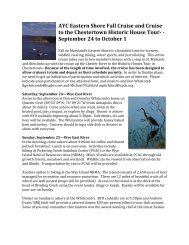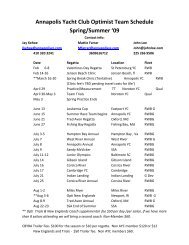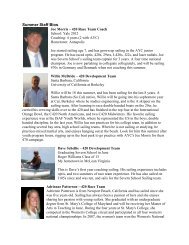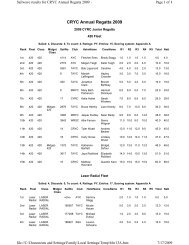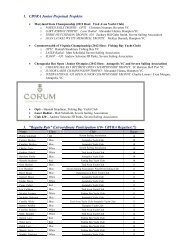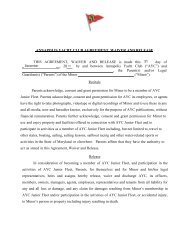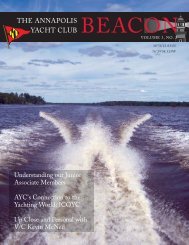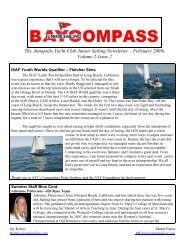You also want an ePaper? Increase the reach of your titles
YUMPU automatically turns print PDFs into web optimized ePapers that Google loves.
debriefs. AYC is keeping up with those year-round<br />
warm-weather programs and setting the standard for<br />
junior sailing support nationwide.<br />
Coaching, the foundation of the programs, comes<br />
in all forms, from older junior sailors to college sailors<br />
on summer break. It’s the norm today for juniors to be<br />
exposed to Olympic coaches and sailors. Lessons and<br />
practices are organized and follow a curriculum and lesson<br />
plans. This structure is overseen by a sailing professional.<br />
Most larger programs have at least one full-time,<br />
year round person. At <strong>Annapolis</strong>, we have one full-time<br />
coach and a Waterfront Director, who steer the program<br />
in the right direction for the more than 300 sailors participating<br />
in our program each year.<br />
With all major programs aiming at the national<br />
level, the only place left to go is overseas. Ten years ago,<br />
there were only three, but now there are numerous opportunities<br />
to travel internationally as an Opti sailor. The<br />
<strong>Club</strong> 420 and Laser/Radial provide a great foundation,<br />
but many top programs in the U.S. are embracing the<br />
International 420 and Laser for their sailors. Generally,<br />
sailors are flocking to the boats that are teaching and challenging<br />
them day in and day out. The “fun factor” is a high<br />
priority and must be there for the program to succeed.<br />
Like the CBYRA schedule, the national youth regatta<br />
circuit has become an institution with the same<br />
events coinciding with the same weekends and holidays,<br />
Opti Mid-winters in the fall, the Orange Bowl in Miami<br />
over Christmas break with Optis, Lasers and 420s,<br />
Martin Luther King Day in Florida or California for<br />
Youth World Qualifier, President’s Day weekend in<br />
February on both coasts of Florida (Opti’s in St. Pete,<br />
420s and Lasers in Stuart). These days, it is not uncommon<br />
to see a bunch of juniors in Miami for the<br />
Olympic classes’ regatta. In 30 years, junior sailing has<br />
come a long way!<br />
junior sailing essay<br />
What Sailing Means to Me<br />
Harrison Hawk<br />
Junior sailor Harrison Hawk is a 13 year-old eighth grader at the<br />
Key School in <strong>Annapolis</strong>. In 2008, Harrison had a breakthrough<br />
sailing year when he qualified for the U.S. National Optimist<br />
Team at the USODA Team Trials hosted by AYC. From there, Harrison<br />
went on to represent the U.S. in his first international regatta<br />
in Wales in August 2008, finishing in the top 20. Sailing again at<br />
the USODA Midwinter Championships in New Orleans, Harrison<br />
earned a spot on the U.S. Team competing in the 24th International<br />
Easter Regatta in Braassemermeer, Netherlands.<br />
Harrison has competed successfully throughout the summer of<br />
2009 on the Chesapeake and, as a result, earned the opportunity<br />
to represent CBYRA and AYC at the Middle Atlantic Midget<br />
Championships held on Long Island Sound out of Indian Harbor<br />
<strong>Yacht</strong> <strong>Club</strong> in Greenwich, Conn. Harrison won the single handed<br />
division (Optimist) class and brought home the perpetual trophy<br />
to AYC.<br />
Harrison is the son of Wynee Hawk (AYC member) of Eastport<br />
and Andrew Wigglesworth of Philadelphia.<br />
I<br />
play many different sports, but sailing is my favorite. It isn’t<br />
one of those sports where you just throw a ball around (of<br />
which I play several); sailing actually has meaning and<br />
gives me a feeling that I don’t have in other sports.<br />
When I thought about “What Sailing Means to Me,” I realized<br />
it is an escape. I don’t need to worry about homework<br />
or my social life, just where the wind is, and keeping my boat<br />
flat. If ever I am angry or upset, being on the water in my boat<br />
helps me to forget my troubles and just have a good time.<br />
Harrison racing in no wind. Photo courtesy of Wynee Hawk<br />
On the other hand, there is the social aspect of this great<br />
sport. When sailing, I have strengthened bonds with old<br />
friends and made new ones. I have been privileged to be a<br />
part of the United States National Optimist Team. Through this<br />
opportunity, I have met and made so many new friends. That’s<br />
not even including the friends I’ve made overseas on two<br />
international sailing trips.<br />
Another aspect is how what you learn from sailing sticks<br />
with you and grows with you your whole life. My first regatta<br />
was the 2005 Halloween Howl at AYC. There were 11 boats<br />
in green fleet. Since then, I’ve sailed in a fleet of 462 boats,<br />
with 100 boats on the line at the start, as it was at the 2007<br />
New England Championships.<br />
There are many lessons to be learned from sailing. It is helping<br />
me to become self-sufficient and independent. What is so<br />
great, to me at least, is that how you sail is all in your own<br />
hands. You don’t need to rely on any person (in single-handed<br />
boats)—you just pray that it blows. If you mess up, you can’t<br />
blame it on anyone but yourself. You just need to learn from<br />
your mistakes and move on.<br />
My sailing career has just started and I know that as I grow<br />
older, I’ll keep sailing and I’ll keep learning.<br />
VOLUME 1, NO. 2<br />
AYC BEACON<br />
19


